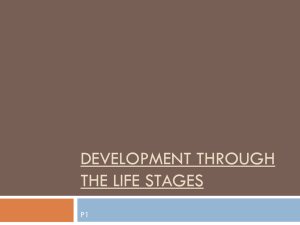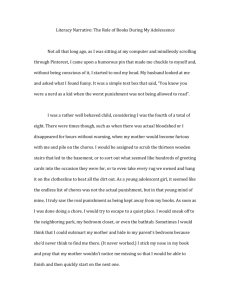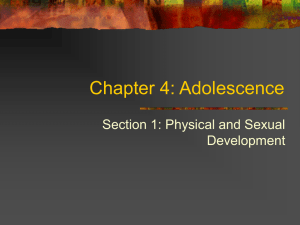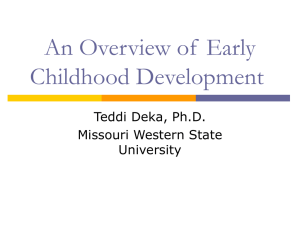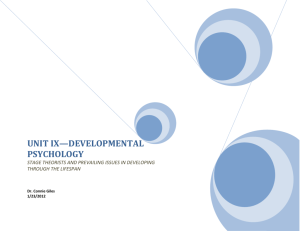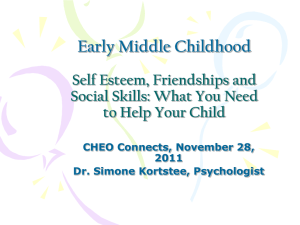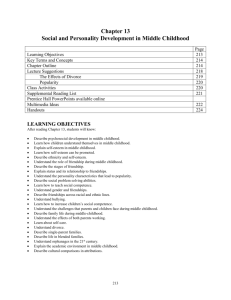final exam review sheet
advertisement
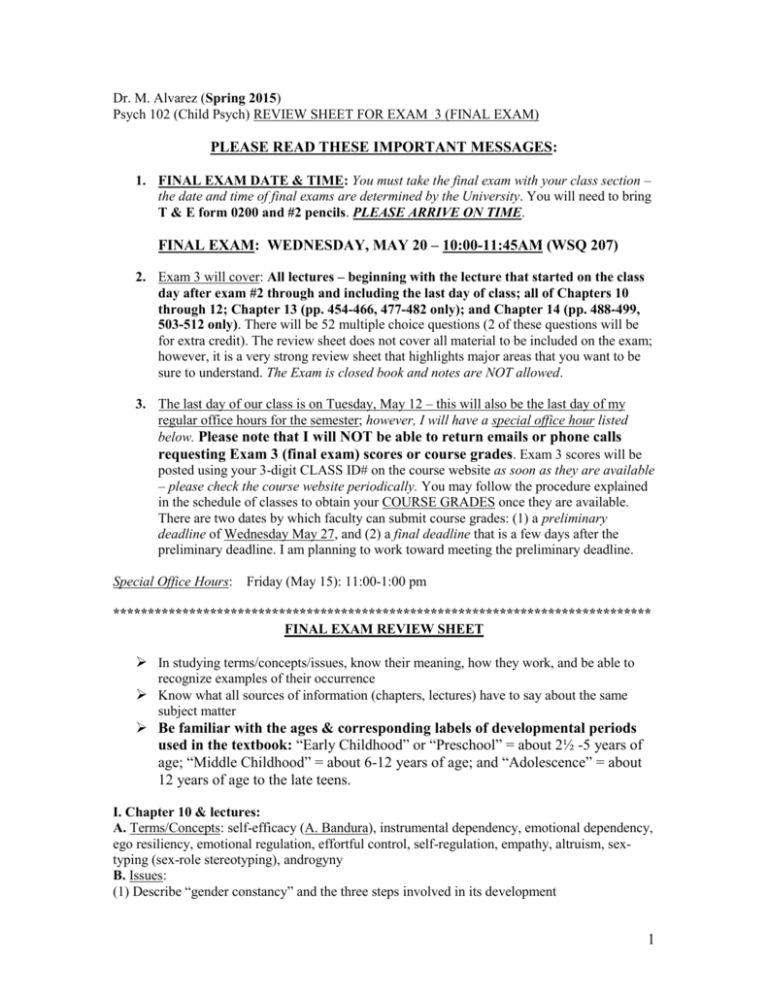
Dr. M. Alvarez (Spring 2015) Psych 102 (Child Psych) REVIEW SHEET FOR EXAM 3 (FINAL EXAM) PLEASE READ THESE IMPORTANT MESSAGES: 1. FINAL EXAM DATE & TIME: You must take the final exam with your class section – the date and time of final exams are determined by the University. You will need to bring T & E form 0200 and #2 pencils. PLEASE ARRIVE ON TIME. FINAL EXAM: WEDNESDAY, MAY 20 – 10:00-11:45AM (WSQ 207) 2. Exam 3 will cover: All lectures – beginning with the lecture that started on the class day after exam #2 through and including the last day of class; all of Chapters 10 through 12; Chapter 13 (pp. 454-466, 477-482 only); and Chapter 14 (pp. 488-499, 503-512 only). There will be 52 multiple choice questions (2 of these questions will be for extra credit). The review sheet does not cover all material to be included on the exam; however, it is a very strong review sheet that highlights major areas that you want to be sure to understand. The Exam is closed book and notes are NOT allowed. 3. The last day of our class is on Tuesday, May 12 – this will also be the last day of my regular office hours for the semester; however, I will have a special office hour listed below. Please note that I will NOT be able to return emails or phone calls requesting Exam 3 (final exam) scores or course grades. Exam 3 scores will be posted using your 3-digit CLASS ID# on the course website as soon as they are available – please check the course website periodically. You may follow the procedure explained in the schedule of classes to obtain your COURSE GRADES once they are available. There are two dates by which faculty can submit course grades: (1) a preliminary deadline of Wednesday May 27, and (2) a final deadline that is a few days after the preliminary deadline. I am planning to work toward meeting the preliminary deadline. Special Office Hours: Friday (May 15): 11:00-1:00 pm ****************************************************************************** FINAL EXAM REVIEW SHEET In studying terms/concepts/issues, know their meaning, how they work, and be able to recognize examples of their occurrence Know what all sources of information (chapters, lectures) have to say about the same subject matter Be familiar with the ages & corresponding labels of developmental periods used in the textbook: “Early Childhood” or “Preschool” = about 2½ -5 years of age; “Middle Childhood” = about 6-12 years of age; and “Adolescence” = about 12 years of age to the late teens. I. Chapter 10 & lectures: A. Terms/Concepts: self-efficacy (A. Bandura), instrumental dependency, emotional dependency, ego resiliency, emotional regulation, effortful control, self-regulation, empathy, altruism, sextyping (sex-role stereotyping), androgyny B. Issues: (1) Describe “gender constancy” and the three steps involved in its development 1 (2) Compare and contrast “cognitive-developmental” (same as “cognitive”), “social-learning”, and “gender-schema” explanations of sex-typed behavior and gender-role development (3) Describe/define “ethnic group” and “ethnic identity”. (4) Describe the findings of David Cordua’s “doctor/nurse” study discussed in class. (5) What was the main conclusion of studies using the children’s program, “Freestyle”? (6) Know Diana Baumrind’s parenting categories and the implications of different styles of parenting for children (i.e., authoritative, authoritarian, and permissive styles). Also, what are some examples of how the appropriateness of different styles of parenting may depend on the context (e.g., one’s subculture or one’s neighborhood environment – see pp. 357-358 of text)? (7) What are the main purposes/functions of children’s play? (8) What were the findings of Langlois & Downs’ study on children’s play with “genderinappropriate” toys (see p.342 of text)? (9) Know the general nature of gender-role expectations for males and females in our society (“instrumental” and “expressive”) (10) Describe preschoolers’ early friendships. How do preschoolers differ in their interactions with friends and non-friends (for example, see section on “Early Friendships” on page 347)? (11) Describe developmental changes in aggression. Also, what’s the difference between “instrumental” and “hostile” aggression? (12) Describe the process of internalizing standards. How can we tell that children are internalizing others’ standards to themselves? II. Chapter 11 & lectures: A. Terms/Concepts: metacognition, culture-fair and culture-free intelligence tests, academic and practical intelligence, decontextualized thought B. Issues: (1) Connect the following names with their specific ideas about the concept of “intelligence”: Alfred Binet, Charles Spearman, Howard Gardner (theory of multiple intelligences), and Robert Sternberg (triarchic theory) (2) Describe main concerns regarding cultural bias and intelligence tests. For example, how could one’s cultural background influence IQ test performance? (3) What do IQ tests scores best predict? (4) Describe how the format or style of social interactions expected at school may be unfamiliar to some children (e.g., Shirley Brice-Heath’s study and others illustrating “cultural mismatch” – see pp. 404-405 of the text) (5) Describe “cooperative” and “didactic” learning experiences. Compare Piaget’s and Vygotsky’s approaches with regard to cooperative and didactic learning situations (6) What’s the difference between a “contingent truth” and a “necessary truth”? III. Chapter 12 & short lecture: A. Guide: You are responsible for all of Chapter 12. However, there are certain aspects of this chapter that are emphasized on the exam: (a) peer relationships in middle childhood (pp. 417425), and (b) contexts of development in middle childhood (pp. 426-436). B. Issues: (1) The text discusses the idea that peer interactions have more equal status than adult-child interactions. Summarize the major benefits promoted by peer group relations/interactions because of this greater equal status (e.g., learning to regulate aggression, etc.) (2) Describe the major advances that occur during middle childhood that allow for increasingly complex and more mature peer relations (e.g., better ability to understand perspectives, needs, feelings of others, etc.) (3) What is “relational aggression”? 2 (4) How do definitions and expectations of a friend/friendships during middle childhood differ from those of younger (preschool) children? (See sub-section on “Forming Loyal Friendships” on pp. 418-420) (5) What are the differences between boys’ and girls’ peer groups in middle childhood? (See subsection on “Forming Peer Groups” on pp. 420-421) (6) Describe the notion of “border work” and gender segregation (7) What is sociometrics? What are some basic characteristics of “accepted”, “rejected”, and “neglected” children? Also, describe “unpopular” children; how can the status of “unpopular” children be improved? (See section on “Status and Acceptance in the Peer Group” on pp. 423425) (8) Describe how parent interactions with their children during middle childhood years are influenced by the child’s gender (e.g., what are some typical gender-related socialization goals and expectations parents often have for daughters and sons? – see sub-section on “Parent-Child Relationships” on p. 427) (9) See sub-section on “Family Violence, Conflict, and Divorce” on pp. 430-432 for information on how age and child gender influence children’s reactions to divorce. Also, many children whose parents divorce develop well; what are some things that seem to help children cope with divorce? (10) What sort of approaches in teaching math and science seem to result in better performance in these subjects by girls (see pp. 434 - 435 of text)? IV. Chapter 13 (pp.454-466, 477-482) AND Chapter 14 (pp. 488-499, 503-512): (1) Be familiar with the ages and general descriptions of the sub-stages of adolescence: “early adolescence”, “middle adolescence”, and “late adolescence” as they are explained on the bottom of p. 454. (2) How is puberty defined/described? What are the indicators or markers of puberty and the “normal” range for beginning and ending this process (for example, describe/define “menarche” in girls and “spermarche” in boys)? Know the “normal” age ranges suggested by James Tanner. (See section on “Puberty: Norms and Individual Differences” on pp. 456-457) (3) How do the physical developments accompanying puberty affect an individual’s body image during early adolescence? What is the role of gender in this process? (See sub-section on “Puberty and Body Image” on pp. 462- 464) (4) Know the ideas of David Elkind regarding adolescent egocentrism and the meaning of the terms, imaginary audience and personal fable. Be able to recognize examples of Elkind’s terms. (5) Describe James Marcia’s four identity statuses. What are some important identity issues for ethnic minority youth? (See sub-section on “Individual Differences in Identity Formation” on pp. 496-499) (6) Describe key ways in which family interaction patterns may change during adolescence and may require a series of “realignments”/ “redefinitions” between parent and their adolescent child (see section on “The Changing Family Structure”, pp. 506-509). (7) Describe the impact of divorce on adolescents (see section on “The impact of Divorce on Adolescents” on pp. 511-512) 3
